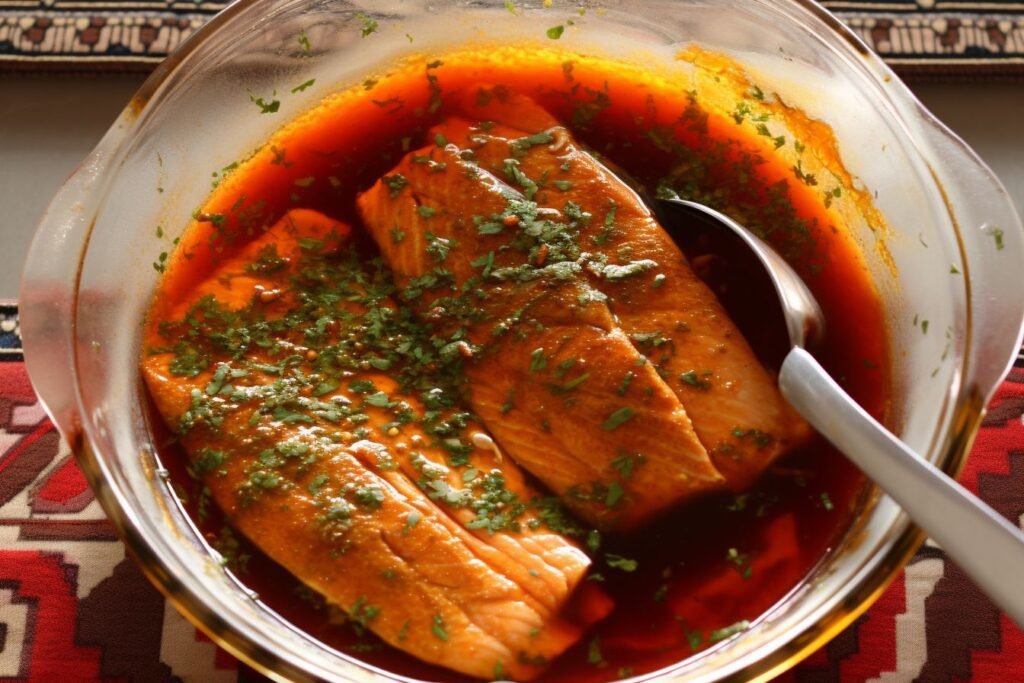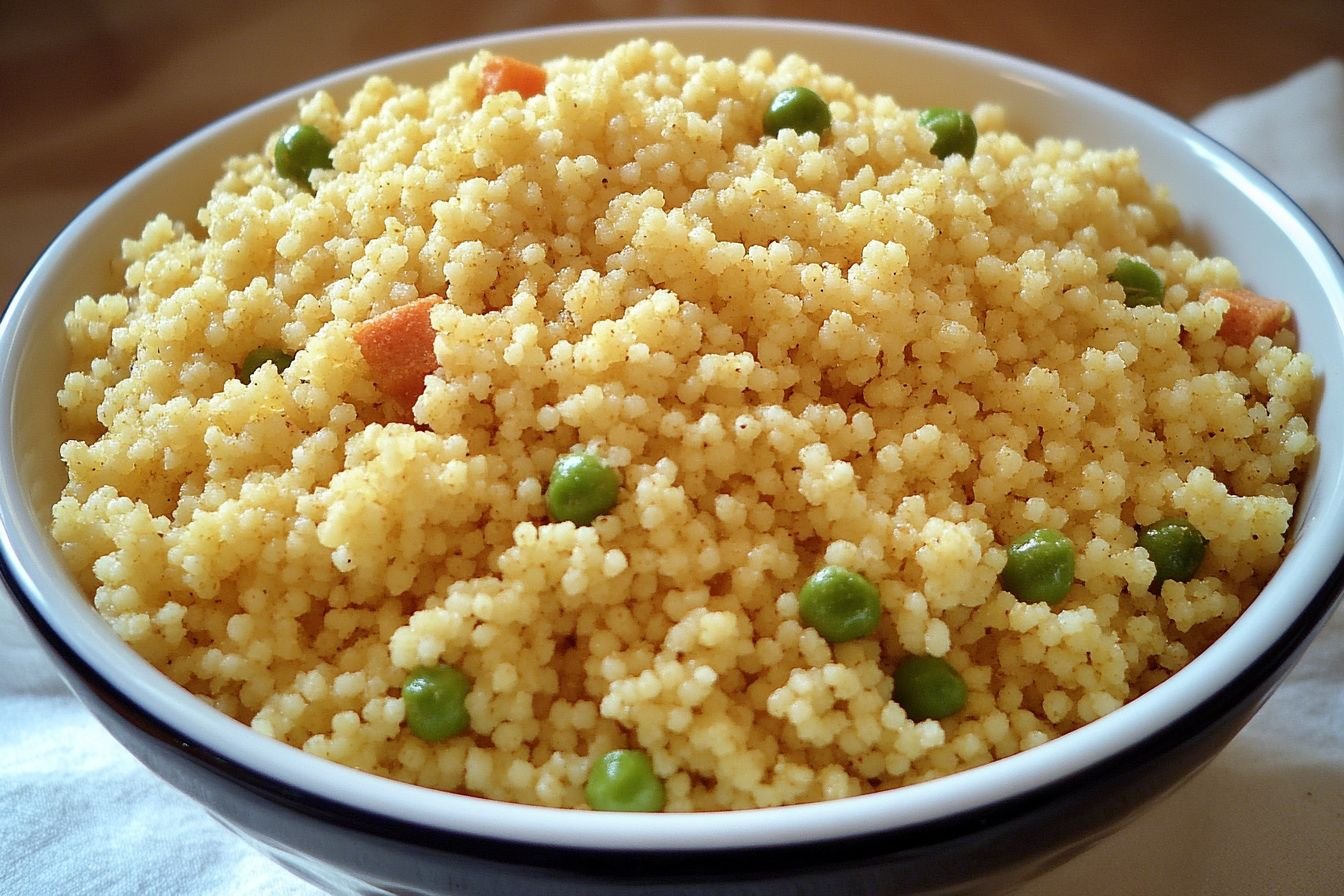Couscous with spices offers a delightful blend of flavors that tantalizes the taste buds. This dish is not only easy to prepare but also bursts with vibrant tastes thanks to ingredients like ground coriander, cumin, turmeric, ginger, cinnamon, black pepper, olive oil, minced onion, garlic, chopped carrot, orange juice, fresh or thawed peas, and the key element—couscous itself.
This is an excellent choice for a quick meal or a potluck favorite. The spices come together in a wonderful harmony, enhancing the fluffy couscous and transforming simple ingredients into a memorable feast.
What Is Couscous?
Couscous is a staple food from North Africa, made from semolina wheat. It consists of tiny granules, typically steamed and served as a side dish or base for various recipes.
I often enjoy its light and fluffy texture. It absorbs flavors beautifully, making it perfect for pairing with meats, vegetables, and an array of spices.
You can also find different varieties, such as whole wheat or flavored couscous, which adds even more options to my meals.
Ingredients:
- 1/2 teaspoon of ground coriander
- 1/2 teaspoon of ground cumin
- 1/2 teaspoon of salt
- 1/2 teaspoon of turmeric powder
- 1/2 teaspoon of ground ginger
- 1/2 teaspoon of ground cinnamon
- 1/4 teaspoon of black pepper
- 2 tablespoons of olive oil
- 1/2 cup of minced onion
- 1 minced large garlic clove
- 1 chopped medium carrot
- 1/2 cup of orange juice
- 1-1/2 cups of cold water
- 1 cup of dry couscous
- 1 cup of fresh green peas (if using frozen, thaw for a few minutes)
How to make couscous with spices?
- begin by combining spices in a small bowl.
- Sauté garlic, onion, and carrot in olive oil until the onion softens.
- Add orange juice and water, bring to a boil, then remove from heat.
- Stir in couscous, peas, and spice mixture.
- Cover and let rest for 5 minutes.
- Fluff with a fork and enjoy!
Pairing Couscous with Meals
Complementing Flavors
When I pair couscous with meals, I focus on complementary flavors. For instance, adding roasted vegetables like bell peppers and zucchini enhances its earthy quality.
Suggested Combinations:
- Couscous with Herbs and Lemon: Brightens the dish and adds freshness.
- Spicy Harissa: Offers a kick that contrasts nicely with couscous’s mildness.
I also love incorporating proteins. Grilled chicken or chickpeas add richness. Mixing in nuts, such as almonds or pine nuts, brings a delightful crunch. Including fruits like raisins or pomegranate seeds adds bursts of sweetness, enhancing the overall experience.
Creating a Balanced Dish
To ensure a balanced dish, I think about textures and colors. A combination of crispy, tender, and juicy elements works beautifully.
Example Plate:
- Base: Fluffy couscous
- Protein: Grilled shrimp
- Veggies: Sautéed spinach and cherry tomatoes
- Extras: Crumbled feta and a sprinkling of toasted sesame seeds
These components not only create visual appeal but also meld well together. I also consider the nutritional aspect. Pairing couscous with a variety of vegetables ensures a range of vitamins and minerals. This balance turns a simple meal into a satisfying dining experience.
Storing and Reheating Couscous
Storing Couscous
- Cool it Down: Let the couscous cool completely before storing it. This prevents condensation in the container.
- Use Airtight Containers: Transfer the cooled couscous into airtight containers. This helps keep moisture out and maintains freshness.
- Refrigeration: Couscous can stay fresh in the fridge for about 3 to 5 days. Always label the container with the date for reference.
- Freezing: If I want to store couscous for longer, I freeze it. It can last up to 2 months. I separate it into portions for easy use.
Reheating Couscous
- Stovetop Method: Add a splash of water to the couscous in a saucepan. Heat over low, stirring frequently until warmed through.
- Microwave Method: Place couscous in a microwave-safe bowl. Add a few tablespoons of water, cover with a lid or microwave-safe wrap, and heat for 1-2 minutes.
- Add Flavor: I often add olive oil or a sprinkle of spices while reheating for extra flavor.
Common Mistakes to Avoid
- Using too much water: Couscous absorbs water quickly. I always measure carefully to avoid a mushy texture. The right ratio usually is 1:1 for couscous and water.
- Not fluffing after cooking: After steaming, I let it sit and then fluff. This step prevents clumps and enhances the lightness of the couscous.
- Skipping the toasting step: Toasting the couscous adds depth and nuttiness. I simply heat it in a dry pan before cooking for optimal flavor.
- Overseasoning: While spices are essential, too much can become overwhelming. I start with small amounts and adjust as needed.
- Ignoring rest time: After cooking, I let the couscous rest for a few minutes. This helps it absorb flavors and improves the texture.
- Forgetting garnishes: I often enhance my dish with fresh herbs, nuts, or raisins. These garnishes add texture and enrich the flavor profile.
Conclusion
Couscous with spices offers a delightful combination of flavors and aromas. Preparing it allows me to explore various spice blends and culinary traditions. I enjoy how versatile it can be.
When I create a dish, I often include spices like cumin, coriander, and paprika. These enhance the taste and contribute to a wonderful fragrance.
Each ingredient brings something unique to the table. This adaptability makes couscous a staple in my kitchen.
The process of making couscous is satisfying and quick. It suits any occasion, from casual dinners to special gatherings.
I always feel proud serving a flavorful bowl of couscous, showcasing my cooking skills. Cooking this dish has become a favorite way to share my love for spices and delicious meals.
Did you know? This can be a great pairing for Moroccan fish tagine!
Interested? Get the recipe now (by clicking the image below):






